Brassicaceae (Mustard family)
At a Glance
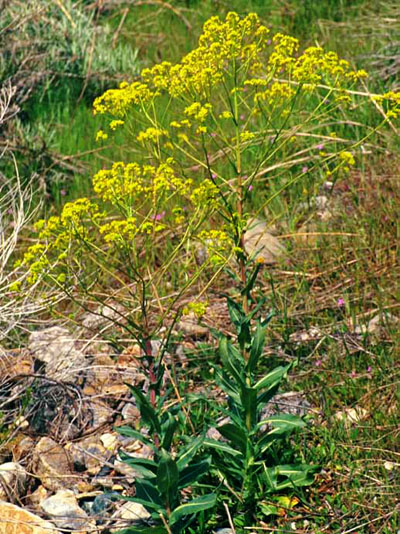
© Steve Dewey / Utah State University
- Biennial, sometimes an annual or a short-lived perennial
- Exists as a basal rosette for a growing season before growing flowering stems.
- Flowering stems grow to 25 to 40 inches tall.
- Basal rosette leaves have conspicuously pale veins. Stem leaves are alternate and attach directly to the stem.
- Bright yellow flowers are borne in clusters at the ends stem branches.
- Fruit is a blackish silicle that droops from a slender stem.
Habitat and Ecology
Native to southeastern Russia, dyer’s woad (Isatis tinctoria) is now invasive across the intermountain West of the US. Early European settlers to the east coast cultivated the plant for its dye, but despite its early introduction, dyer’s woad did not become truly invasive until its introduction to California and Utah as a contaminant in alfalfa seed. Dyer’s woad often grows on dry, coarse-textured, rocky soils. It is capable of invading both undisturbed and disturbed sites, such as roadsides, railroad right-of-ways, fields, pastures, grain and alfalfa fields, forests, and rangeland, especially big sagebrush (Artemisia tridentata) communities. Dyer’s woad is highly competitive, often completely dominating a site. It spreads rapidly once established.
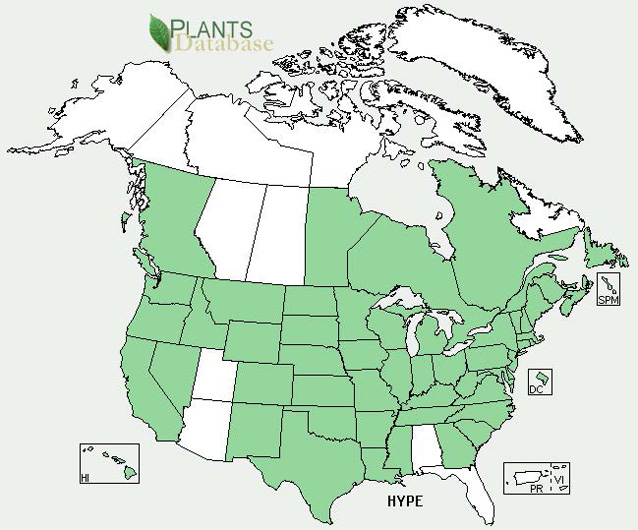
USDA
Description
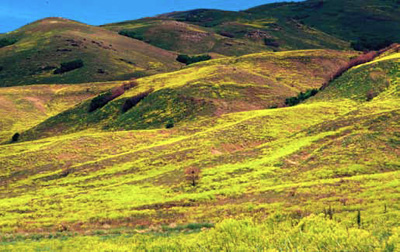
© Steve Dewey / Utah State University
Dyer’s woad is an erect biennial herb that grows to four feet tall. It can also sometimes act as an annual or shortlived perennial. Before growing its flowering stems, the plant exists as a basal rosette for a growing season. The gray to purplish flowering stems typically branch near the top. The root system consists of a fleshy taproot that can grow more than five feet deep and smaller lateral roots that spread outwards near the surface. Dyer’s woad reproduces by seed, although plants cut above the root crown can resprout. Most of the fruits fall near the parent plants, but some fruits disperse via wind, human activities, and as seed and hay contaminants. The fruit coats contain watersoluble inhibitors that prevent seeds from germinating until leaching occurs, allowing the plant to germinate under favorable conditions.
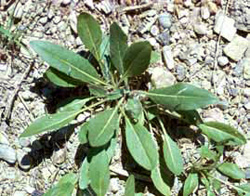
© Steve Dewey / Utah State University
Leaves
The leaves of the basal rosette have long stems and conspicuously pale midveins. They may be covered with simple long hairs, especially on the veins. The edges are weakly toothed to wavy. The stem leaves, which are alternate, attach directly to the stem. Shaped like arrowheads, the leaves become progressively smaller up the stem.
Flowers and Fruits
The bright yellow flowers are borne in a highly branched inflorescence that is either flat-topped or umbrella-shaped. Each small flower has six stamens and four petals that are spoon-shaped. Dyer’s woad flowers April through June.
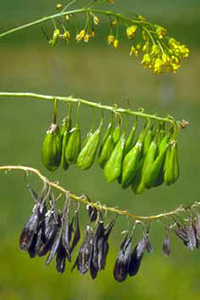
© Steve Dewey / Utah State University
The fruit is a flattened pod that does not open at maturity. The black to purplish-black fruits droop from slender stems. Each pod contains one seed. The dull yellowish seeds are grooved into two unequal halves.
Etymology
I’satis is the Greek name for this herb. Tinctor’ia usually refers to a plant that can stain when broken open.
Ethnobotany
Dyer’s woad has been cultivated in Europe since ancient times as a medicinal herb and a source of blue dye.
Similar Species
Dyer’s woad can be distinguished from other members of the mustard family by its unique fruits.
Control Methods
Possible control methods are explained at these websites:
References
California Department of Food and Agriculture. No date. Dyer’s woad in Encycloweedia. Available at https://www.cdfa.ca.gov/plant/ipc/encycloweedia/weedinfo/isatis.htm (accessed 7 April 2010).
Charters, M. L. 2009. California plant names: Latin and Greek meanings and derivations. Available at http://www.calflora.net/botanicalnames (accessed 7 April 2010).
Rollins, R. L. 1993. Isatis tincoria in Hickson, J. C., editor. The Jepson manual: higher plants of California. Available at http://ucjeps.berkeley.edu/eflora/eflora_display.php?tid=29342 (accessed 7 April 2010).
Zouhar, K. 2009. Isatis tinctoria in Fire Effects Information System. US Department of Agriculture, Forest Service, Rocky Mountain Research Station, Fire Sciences Laboratory. Available at http://www.feis-crs.org/feis/ (accessed 8 April 2010).
Prepared by Kelly Reeves, Southern Colorado Plateau Network Inventory and Monitoring Program, 2010.
Last updated: June 28, 2016
